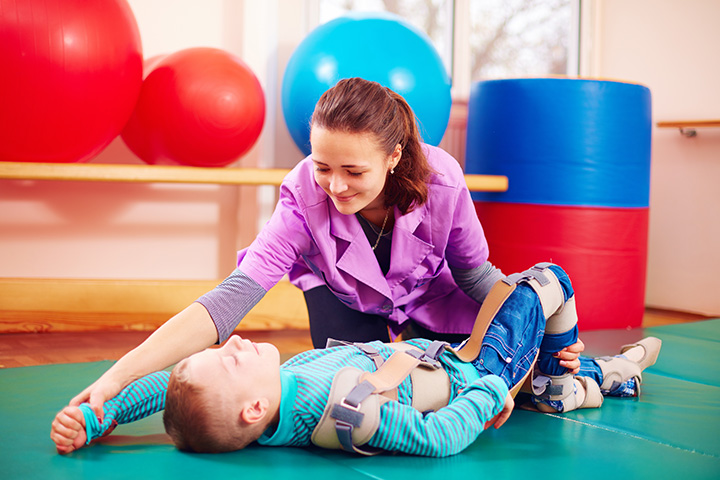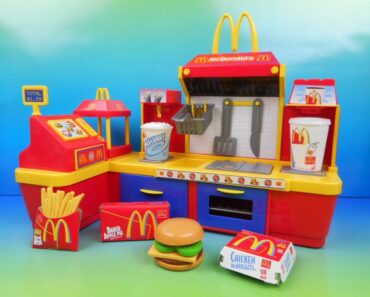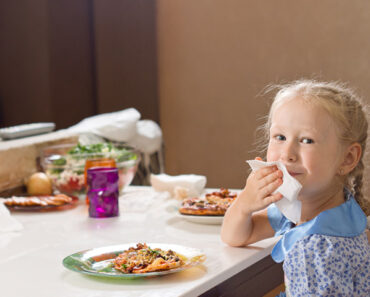image: Shutterstock
Cerebral palsy (CP) is a non-progressive neurological disorder that affects a child’s ability to balance, move, and maintain posture. Muscle stiffness, floppiness, involuntary movements, and abnormal postures are commonly seen in children with cerebral palsy.
CP is considered the most common motor disability in childhood, and studies suggest that it occurs in 1 to nearly 4 per 1,000 live births or per 1,000 children (1).
The signs and symptoms of cerebral palsy are generally seen from infancy in most children. However, in some children, the symptoms of mild cerebral palsy may go unnoticed until school age. Also, the severity and symptoms of cerebral palsy may vary in each child depending on the brain area involved.
Read this post to know about the signs and symptoms, causes, risk factors, types, complications, prevention, diagnosis, and treatment options for cerebral palsy in children.
Signs And Symptoms Of Cerebral Palsy
The signs and symptoms of cerebral palsy may vary in each child. However, coordination and movement problems are commonly seen in most children affected with the condition, and the signs and symptoms may become more or less apparent over time. Generally, the symptoms do not worsen with age since the brain abnormalities do not change over time (2).
The common signs and symptoms of cerebral palsy in children may include (3) (4)
- Changes in muscle tone, such as hypertonia (too stiff) or hypotonia (too floppy).
- Spasticity — stiff muscles and increased reflexes.
- Rigidity — stiff muscles with normal reflexes.
- Ataxia — lack of muscle coordination and balance
- Tremors — involuntary movements
- Walking difficulties and abnormal gait, such as scissors-like gait with crossed knees, wide gait, a crouched gait, walking on toes, and other asymmetrical gaits
- Preference for one side of the body
- Excessive drooling
- Swallowing and eating difficulties
- Speech and learning difficulties
- Seizures
- Fine motor skills problems — difficulty in picking up something, buttoning clothes, etc.
Depending on the brain area affected, cerebral palsy can involve the whole body or be limited to the limbs or one side of the body. Cerebral palsy may also cause the following problems in some children (5).
- Vision problems
- Hearing issues
- Mental health disorders
- Intellectual disabilities (low IQ)
- Abnormal perceptions of pain or touch
- Seizures
- Oral diseases
- Urinary incontinence — involuntary leakage of urine
Causes Of Cerebral Palsy
Disruption to brain development before birth is the primary cause of cerebral palsy. It can also be due to brain damages in the infantile period before the brain is fully developed. However, the exact cause is not identified in many children with cerebral palsy. The common causes of cerebral palsy may include (6) (7)
- Gene mutations.
- Fetal stroke that affects the blood supply to the fetal brain.
- Maternal infections passing to the fetus.
- Brain hemorrhages (bleeding) before or after birth.
- Brain infections in infancy.
- Traumatic head injuries in infancy such as fall from height or motor vehicle accidents.
- Lack of oxygen (hypoxia) in the brain, such as birth-related asphyxia.
Any of the conditions listed above during pregnancy or infancy requires immediate care since it may affect the baby’s brain development.
Risk Factors For Cerebral Palsy
Any condition that affects fetal or infantile brain development could increase a child’s risk for cerebral palsy. Maternal exposure to certain toxins and infections in pregnancy may increase the risk for cerebral palsy in babies. The risk factors for CP may include (8)
- Cytomegalovirus infection
- Rubella or German measles
- Syphilis
- Herpes infection
- Zika virus infection
- Toxoplasmosis
- Toxins such as methyl mercury
- Thyroid abnormalities
The following birth-related factors may also slightly increase the risk for cerebral palsy in children (8)
- Premature birth, higher risk if born before 28 weeks
- Breech presentation — when the fetus presents buttocks or feet first
- Low birth weight (less than 2.5kg)
- Multiple births
The following illnesses during infancy may also potentially increase the risk for cerebral palsy in children.
- Viral encephalitis
- Untreated or severe jaundice and kernicterus
- Bacterial meningitis
- Cerebral hemorrhage
Although the factors listed above may increase the risk for cerebral palsy, not all babies exposed to them develop it. However, taking precautions and early medical care may help avoid the condition.
Complications Of Cerebral Palsy
Muscle weakness or stiffness and coordination issues due to cerebral palsy may contribute to the following complications in children (4).
- Malnutrition: Swallowing problems may result in malnutrition, and some children with cerebral palsy may require feeding tubes to meet their nutritional needs.
- Muscle tissue shortening: Severe muscle spasticity or tightening can lead to shortening of muscle tissues or contracture. This may cause bone bending and joint deformations and inhibit bone growth in some children.
- Mental health disorders: Difficulties due to the condition and social isolation may increase mental health problems such as depression in some children.
- Cardiopulmonary diseases: Children with cerebral palsy are more likely to develop heart and lung diseases such as pneumonia and other breathing disorders.
- Osteoarthritis: Increased pressure and abnormalities of joints due to muscle spasticity may result in degenerative joint diseases at an early age.
- Bone fractures: Decreased mobility, antiseizure drugs, and nutritional deficiencies may increase the risk of bone fractures due to low bone mineral density (osteopenia).
Individuals with cerebral palsy may face premature aging in their early 40s due to stress and strain caused by the condition. Medical therapies and regular follow-ups may help control or reduce these complications.
Prevention Of Cerebral Palsy
Cerebral palsy is not preventable in many cases. However, taking the following precautions before conception or during pregnancy and infantile period may help reduce your child’s risk of cerebral palsy (9).
- Get vaccinated against rubella and other infections before planning pregnancy.
- Treat existing infections and thyroid problems before pregnancy.
- Seek early prenatal care and plan delivery as recommended.
- Avoid illegal drugs, smoking, and alcohol during pregnancy.
- Ensure child safety by fixing rails on the bed, using a child seat on your car, etc.
- Vaccinate your baby and treat infections on time.
Preconception care and early prenatal care may help reduce certain cerebral palsy risk factors.
When To See A Doctor
Seek prompt pediatric care if you notice movement issues, developmental delays, or any of the symptoms of cerebral palsy mentioned above. An expert should evaluate episodes of loss of consciousness or awareness, seizures, or inability to do school tasks.
Learning difficulties can be due to neurological problems in some children. Seek medical care to identify and treat the cause. If your child is already diagnosed with cerebral palsy, never hesitate to follow the recommended therapies since this may improve your child’s quality of life.
Diagnosis Of Cerebral Palsy
Diagnosis is usually made a few months after birth since the signs and symptoms typically become apparent over time. If there is a concern, pediatricians may monitor the child’s growth and development and evaluate their health history. Referral to pediatric neurologists and developmental specialists is often done for further evaluation.
The following tests are often ordered to diagnose cerebral palsy and exclude other possible causes (4).
1. Laboratory tests
Lab analysis of blood and urine helps screen genetic and metabolic issues. This may also help identify the presence of certain infections in babies. Spinal tap and lab analysis of CSF (cerebrospinal fluid) is often recommended to diagnose brain infections.
2. Brain scans
Brain imaging scans help visualize the brain areas with abnormal development. The following scans may be ordered.
- MRI (magnetic resonance imaging): In this non-radiation and painless procedure, magnetic fields are used to visualize the inner brain tissues. Sedatives or mild general anesthesia is given before the MRI scan.
- CT (computed tomography): Here, X-ray radiation is used to create brain images. This is often recommended in emergencies, such as traumatic brain injuries. Skull bones are well visible on CT scans.
- Cranial ultrasound: This is only recommended for infants. It may help provide the brain’s basic visuals. This is often recommended as a preliminary test in infancy.
Brain imaging helps plan the appropriate treatment based on the underlying brain abnormalities. Periventricular leukomalacia (white matter injury) and hypoxic-ischemic encephalopathy are typical neuroimaging (brain scans) findings in children with cerebral palsy.
3. Electroencephalogram (EEG)
EEG helps detect the brain’s electrical activity through the electrodes attached to the scalp. This is usually recommended for children with seizures or epilepsy.
4. Other tests
Pediatricians may refer children with cerebral palsy to certain specialists, such as ophthalmologists or neurologists, to evaluate the conditions associated with the disorder. The following tests are often done.
- Developmental analysis
- Vision tests
- Hearing tests
- IQ tests
- Speech tests
- Motor skills analysis
- Movement and coordination analysis
IQ or intelligence quotient tests are almost always done for children with cerebral palsy since most of them may have intellectual disabilities. Results from all evaluations help identify the presence and severity of cerebral palsy. Medical therapies and special training are planned based on the diagnostic results.
Treatment For Cerebral Palsy
No specific treatment exists for cerebral palsy. Long-term medical care with various specialists is often required to manage the symptoms and improve the quality of life. Treatment options for cerebral palsy may include (4) (10).
1. Medications
Muscle relaxant medications are often prescribed for children with cerebral palsy to reduce muscle tightness and improve functional abilities. Medicines given for cerebral palsy may include
- Botulinum toxin injections such as Dysport or Botox to relax spastic muscles. These injections are usually taken every three months.
- Oral muscle relaxants such as Valium (diazepam), Dantrium (dantrolene), Gablofen or Lioresal (baclofen), and Zanaflex (tizanidine) to relax muscles.
- Botox injections to manage excessive drooling.
- Baclofen, which is delivered to the spinal cord with a surgically implanted pump, to manage the symptoms.
Pain due to muscle spasticity can be relieved using muscle relaxants. Children who receive medications need regular follow-up to assess improvement and side effects.
2. Therapies
The following therapies under trained professionals are recommended to manage symptoms of cerebral palsy in children.
- Physical therapy: Muscle exercises and training may help build balance, flexibility, strength, motor skills development, and mobility in children.
- Speech and language therapy: This may help improve communication skills. Speech and language pathologists may usually teach easy verbal communication and sign languages based on the requirement.
Children may also be taught how to use communication devices and technologies such as computers and voice synthesizers. Swallowing and eating problems are also identified and addressed by these specialists.
- Occupational therapy: This may help the child learn daily routines and activities needed at home, school, or outside. Occupational therapists help the child understand the use of electric wheelchairs, seating systems, walkers, and quadrupedal canes (walking sticks).
- Recreational therapy: This is done based on the child’s recreational or sports activities such as skiing or horseback riding. Recreational activities may help improve the child’s speech, motor skills, and emotional wellbeing.
- Psychotherapy: It is recommended for children, especially older children and teens, who have an increased risk for mental health issues due to their conditions.
Therapists may also teach parents to continue training at home. Parents are trained to bathe and feed the child. A combination of therapies is often prescribed based on the symptoms.
3. Surgeries
Bone deformations due to contracture and severe muscle tightness may require surgical care.
Surgery may be needed to lessen muscle tightness or correct bone abnormalities caused by spasticity. The following are some of the common surgical treatments.
- Selective dorsal rhizotomy involves cutting the nerve fibers serving specific muscles. This procedure may help relax spasticity and muscle pain. Some children may experience numbness after the procedure.
- Orthopedic surgery is required for severe bone or joint deformations. The positions of arms, hips, and legs are often corrected surgically.
- Tendon lengthening surgeries may help avoid contracture and related complications in some children.
Surgeries may help improve mobility and lessen pain in some children. They may also help in fitting the braces, walkers, or crutches well.
Although some people try complementary therapies such as hyperbaric oxygen therapy, electrical stimulations, and resistance muscle training, these therapies are not included in the clinical practice since they haven’t shown benefit to date (4).
Types Of Cerebral Palsy
Due to a wide range of clinical presentations and mobility issues, it is challenging to classify cerebral palsy under a single classification system. Cerebral palsy can be classified into various types based on the following factors (11).
1. Classification based on the severity level
Based on severity levels, cerebral palsy can be classified into
- Mild cerebral palsy: Children with mild cerebral palsy can move without assistance, and the condition does not limit their daily activities.
- Moderate cerebral palsy: Children may need medications, braces, and other adaptive devices or technologies to do daily activities.
- Severe cerebral palsy: Children may need a wheelchair and have difficulties accomplishing daily activities.
- No cerebral palsy: Cerebral palsy acquired after brain development is classified into this category. This can be due to a traumatic brain injury or infections after brain development.
Mild cerebral palsy may go undetected until walking age in many children. Some cases may go unnoticed until school age in some children since they can move and do daily activities. Other symptoms such as speech and language issues and low IQ are often noticed in school. Moderate and severe cerebral palsy is usually diagnosed in early childhood itself.
2. Classification based on the topographical distribution
Cerebral palsy can be classified based on the body parts involved. Types of cerebral palsy based on topographic classification may include the following.
- Monoplegia/monoparesis is when one limb (one arm or one leg) is affected.
- Diplegia/diparesis suggests that the legs are more affected than the arms.
- Hemiplegia/hemiparesis involves an arm or leg on one side of the body.
- Triplegia/tripares is when three limbs are involved. This can be both legs and one arm, both arms and one leg, or one arm and leg and the face.
- Paraplegia/Paraparesis involves the lower part of the body, including both legs.
- Tetraplegia/tetraparesis means both arms and legs are affected. But one arm or leg may be less affected than the other three limbs.
- Double hemiplegia/double hemiparesis is when all four limbs are affected, but one side of the body is less affected than the other side.
- Quadriplegia/quadriparesis is when all limbs are equally affected.
- Pentaplegia/monoparesis is when the neck and head are paralyzed along with the four limbs. This may cause severe eating and breathing difficulties in children.
3. Classification based on motor function
Brain injuries that cause cerebral palsy affect the motor functions of the body. This classification categorizes cerebral palsy into the following types based on the clinical presentation.
- Spastic cerebral palsy with hypertonia — characterized by increased muscle tone
- Non-spastic cerebral palsy with hypotonia — characterized by low muscle tone or floppiness)
Spastic cerebral palsy and non-spastic cerebral palsy can also be classified into the following groups based on the location of the brain injury:
1. Pyramidal cerebral palsy (spastic cerebral palsy)
Pyramidal cerebral palsy involves the pyramidal tracts, the motor tracts originating in the brain’s cerebral cortex and terminating in the spinal cord. Neurons in the pyramidal tracts provide voluntary control for muscles in the body and face. Any disruption to the pyramidal tracts increases the muscle tone or stiffness.
This affects more than 80% of people with cerebral palsy. Awkward movements are seen due to spasticity. The condition can be further divided into the following groups depending on the affected body parts (topography):
- Spastic hemiplegia or hemiparesis: Paresis means weakness, and plegia means paralysis of the body part. In this condition, only one side of the body is affected, and the arms are commonly more affected than the legs.
- Spastic diplegia or dipparesis: This may affect both sides of the body part, and the legs are more commonly affected than the arms. Tight leg and hip muscles may cause walking problems, and scissoring of legs (cross leg at the knees) is usually seen.
- Spastic quadriplegia or quadriparesis is the most severe form of cerebral palsy. It affects the face and trunk and the arms and legs on both sides of the body. Children with this condition can be immobile and often have other issues such as vision problems, hearing impairment, speech problems, seizures, and intellectual disabilities.
2. Extrapyramidal cerebral palsy (non-spastic cerebral palsy)
Extrapyramidal cerebral palsy involves the extrapyramidal tracts. These motor tracts, which connect the neurons from the brainstem to the spinal cord, control involuntary and automatic movements of the muscles. Damages to these brain areas could result in uncontrolled, involuntary muscle movements in the body.
Extrapyramidal or non-spastic cerebral palsy can be further divided into dyskinetic cerebral Palsy and ataxic cerebral palsy based on muscle movements.
- Dyskinetic cerebral palsy
Uncontrolled, slow, rapid, jerky, or writhing movements are often seen in children with dyskinetic cerebral palsy. They may also have trouble swallowing and talking as the face and tongue muscles are involved. In this type, the muscle tone may vary from hypertonic to hypotonic during the day. Choreoathetoid, athetoid, and dystonic cerebral palsies come under this type of cerebral palsy. These are grouped based on the type of movements.
Ataxia or balance and coordination problems are seen in children with ataxic cerebral palsy. Children with ataxic CP may have writing difficulties, walking problems, etc.
3. Mixed cerebral palsy
Symptoms of more than one type of cerebral palsy are seen in some children. Spastic-dyskinetic cerebral palsy is the most common mixed type.
4. Classification based on gross motor functions
The gross motor function classification system (GMFCS) classifies cerebral palsy into five categories. These include
- GMFCS level I: Children can walk indoors and outdoors, climb stairs, and do other gross motor tasks such as jumping and running. However, balance, speed, and coordination can be limited.
- GMFCS level II: Children can walk outdoors and indoors and climb stairs holding the rails. They may have difficulty walking long distances and may require physical or device assistance. Their ability to do gross motor activities such as running and jumping may be limited.
- GMFCS level III: Children may need hand-held mobility devices to walk, and they may climb stairs holding to the rails with assistance or supervision. They may also require wheelchair assistance for long distances.
- GMFCS level IV: Children may require powered mobility or physical assistance in most places. They may have to be transported in a manual wheelchair or powered mobility.
- GMFCS level V: Children require a manual wheelchair in all places. They may have limited hand and arm movements and find difficulty maintaining head control and trunk control.
This classification gives an idea about a child’s ability to move and the devices they require for assistance. Other classification systems, such as the manual ability classification system (MACS), classify cerebral palsy into different categories based on a child’s ability to perform fine motor skills such as handling objects. Communication function classification systems (CFCS), on the other hand, help identify the severity of communication problems in children with cerebral palsy.
Your encouragement and support are required for your child to undergo successful therapy sessions and improve their quality of life. You may encourage them to do things independently however small the task. Fostering independence could help them do things on their own. Never hesitate to seek emotional support from friends, family, and support groups.


































